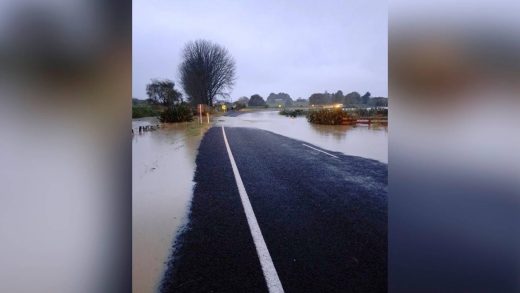
There are some big numbers hidden in the concrete, steel and paint of the Hamilton section of the Waikato Expressway.
The 22km stretch is the final piece in the 102km four-lane highway that’s expected to reduce travel time between Auckland and Tīrau by 35 minutes.
It’s also expected to significantly reduce the number of fatal and serious injury crashes.
The section of road will be officially blessed on July 12 and opened soon after. Here are some key numbers to reflect on when you drive it for the first time.
Christel Yardley/Stuff
The Hamilton section of the Waikato Expressway has 16km of steel W-section barriers and 750 street lights.
READ MORE:
* Waikato Expressway just got more express: 110kph speed limit confirmed
* Bye, bye Hamilton – State Highway 1 says haere rā, Kirikiriroa
* A sneak peek at Hamilton’s new section of Waikato Expressway
* Countdown on for Hamilton section of Waikato Expressway
5,500,000
There have been 5.5 million cubic metres of earth moved. Earthworks generally happened in the summer months with the drier weather – however a wet summer in 2016 was one of the reasons the original completion date was pushed back.
110,000
Asphalt, some 110,000 tonnes of it, was used for the final surface of the road. Most of it was produced from a temporary asphalt plant on site that could produce 140 tonnes an hour. The approximate cost of the plant was $4 million and was put on leased land near the Ruakura Interchange.
10
Three gullies covering 10 hectares were restored in the road’s construction. Native bats were monitored while fish and lizards were relocated into a “lizard hotel”, a pest-protected enclosure east of Hamilton, before being released back into the gullies.
CHRISTEL YARDLEY/STUFF
The Hamilton section, seen here during a sneak preview for media, will be blessed on July 12 and open shortly afterwards.
16
There are 16 bridges on the Hamilton section, 15 of those are concrete and one steel. All bridges were built to survive a 1-in-2000 year earthquake. The tallest bridge is Kay Rd which is 18.8 metres above ground. The longest is Mangaonua bridge at 150m long, which also has the deepest piles at 50m.
110
Drivers will be able to travel at 110kph on the Waikato Expressway between Hampton Downs and south of Cambridge. It means people will be able to safely travel a continuous 78km at the increased speed. There are only two pieces of road in New Zealand with 110kph signs.
7500
There have been 7500 people inducted on to the site over the build, including subcontractors, excluding visitors. There were up to 600 people who worked on the section in the first few years. The contract was awarded in November 2015 to CityEdge Alliance which is made up of Fletcher Construction, Higgins, Beca, Coffey and Waka Kotahi, with Hick Bros a sub-alliance for earthworks.
CHRISTEL YARDLEY/STUFF
There are 16 bridges along the 22km stretch
1.8
A 1.8 hectare reserve was established at a site of cultural significance in Tamahere. There’s an installation of artwork and storyboards along the route and iwi designs on bridge abutments. Bridges were also gifted iwi names.
233
There is 233km of white road marking on the Hamilton section, along with 63km of flexible wire rope, 16km of steel W-section barrier, and 7km of concrete barrier. There are 750 street lights and 700 signs – everything from overhead gantry signs, to destination and smaller directional signs.
837
The cost of the Hamilton section of the Waikato Expressway is $837m.


